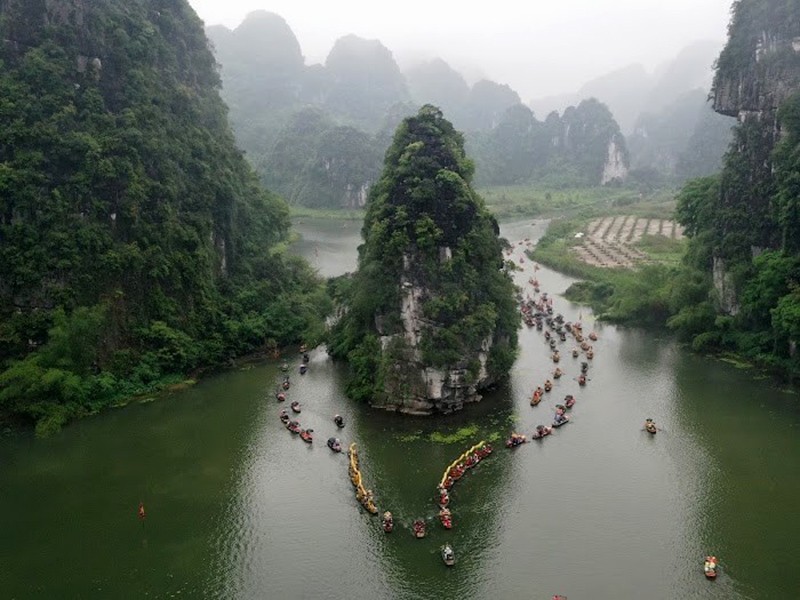
Vietnam shines brightly on the world tourist map
Latest
According to the Vietnam National Administration of Tourism (VNAT), Vietnam continues to be among the top destinations with the fastest tourism growth in the world, with a monthly increase of 50-70% from the beginning of 2022.
These achievements show that Vietnam has always been one of the most favored travel destinations for international tourists. This is a combination of many factors, including the element of enormous tourism potential.
Diverse natural landscape
Vietnam is well-loved by nature, being endowed with many landscapes, from magnificent and majestic to wild and peaceful. Spread across the 63 provinces and cities of Vietnam is the unique beauty of each locality, creating an overall diverse natural picture.
 |
| Golden Bridge in Da Nang. (Photo: Mai Thanh Chuong) |
Vietnam has many famous natural sceneries such as the Ban Gioc Waterfall (Cao Bang), Ha Long Bay (Quang Ninh), Trang An landscape complex (Ninh Binh), Hoi An ancient town (Quang Nam), Phong Nha-Ke Bang National Park (Quang Binh), etc.
Among them, many scenic spots and historical sites have been recognized by UNESCO as world cultural heritages, a major contribution to bringing Vietnam’s image to the international arena.
Historical sites - valuable assets
In addition to diverse and rich natural resources, Vietnam also has many ancient relics.
Currently, Vietnam is home to many historical sites and museums, such as Hung Temple relic, Co Loa temple, Hoa Lu relic site, Khmer Cham tower, Quang Tri ancient citadel, etc.
Historical sites are not only invaluable assets of the nation, but they also hold great tourism value. Besides helping tourists discover and learn about destinations, tourism to historical sites also gives visitors a more depth understanding of Vietnam’s history and its people.
The link between intangible heritage and tourism
Up till now, 14 intangible cultural heritages of Vietnam have been recognized by UNESCO, including the Hue royal court music, Central Highlands gong cultural space, Bac Ninh Quan Ho folk song, Ca Tru, Xoan singing and southern amateur music, etc.
It can be seen that the tourism industry and the preservation of national cultural heritage have a close-knitted relationship with each other. By introducing intangible cultures through tourism activities, Vietnam’s intangible cultural heritages are widely promoted by international visitors, and the country’s tourism industry is also enriched by diverse art forms.
Unique cuisine
Culinary culture is a factor that plays a major role in attracting tourists to each travel destination. It also helps to improve the competitiveness of Vietnam’s tourism.
Thanks to the characteristics of geography, culture, ethnicity, and diverse climate, the cuisine of each region in Vietnam has its own distinct element. This contributes to creating a rich Vietnamese culinary picture but still greatly imbued with the Vietnamese soul.
Promotion of digital tourism
Vietnam is now gradually catching up with the trend of digitization and technology application in the tourism field to meet the increasing demands of international tourists.
A great number of travel companies in Vietnam have digitally transformed into the management and construction of new products. A series of travel service applications were created that now allow visitors to buy tickets, pay expenses, and consult locations, right through a tap of a phone screen.
 |
| Trang An landscape complex in Ninh Binh province. (Photo: Xuan Lam) |
Specifically, in an aim to adapt to the COVID-19 pandemic, many tourism management agencies and some localities have researched and applied digital technology platforms to sightseeing and tourism activities.
For instance, Hanoi is a very active locality in the digital transformation of tourism activities. The Center for Culture and Science of the Temple of Literature applied QR technology to more than 40 artifacts, trees, and other items at the temple in order to assist visitors in providing information in a faster, timely manner and more convenient way.
Bat Trang ancient village (Gia Lam district) is the first craft village in Hanoi to apply VR (virtual reality) technology to help tourists visit the craft village from afar.
Hoa Lo prison attracts visitors through creative activities hosted on social media platforms such as Facebook and Spotify.
These creations and innovations demonstrate the efforts of each locality in embracing the trend of digital transformation, and the application of modern technology as a means of promoting their tourism potential.
| According to the Vietnam National Administration of Tourism (VNAT), Vietnam continues to be among the top destinations with the fastest tourism growth in the world, with a monthly increase of 50-70% from the beginning of 2022. Vietnam welcomed 954,000 international tourists in the first seven months of 2022, a nine-fold increase over the same period last year. Most of the visitors were from Asia-Pacific, including Southeast Asian countries such as Cambodia, Singapore, Thailand and Malaysia. South Korea was Vietnam's largest source of tourists during this period, followed by the US. |

















